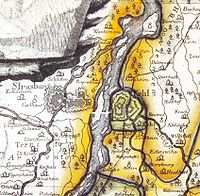Siege of Kehl (1733)
| Siege of Kehl | |||||||
|---|---|---|---|---|---|---|---|
| Part of the War of the Polish Succession | |||||||
 A 1788 map showing Kehl and Strasbourg |
|||||||
|
|||||||
| Belligerents | |||||||
|
|
|
||||||
| Commanders and leaders | |||||||
|
|
|
||||||
| Strength | |||||||
| 25,000 infantry 8,000 cavalry |
250 Imperial troops 1,200 Schwabian militia |
||||||
The Siege of Kehl (14–28 October 1733) was one of the opening moves of the French Rhineland campaign in the War of the Polish Succession, at the fortress town of Kehl in the upper Rhine River valley. A large French army under the command of the Duke of Berwick besieged and captured the fortress, which was lightly garrisoned and in poor condition.
On the death of Augustus II on 1 February 1733, the Polish throne was claimed by both his son, Augustus III, and by Stanislas I, father in law of Louis XV. Whilst a body double ostensibly left Brest by sea, Stanilas crossed Germany incognito and arrived at Warsaw on 8 September. On 12 September Stanislas was elected king of Poland by the diet.
On his election Russia and Austria (backing Augustus III) invaded Poland. By 22 September Stanislas, who did not have a proper army, had to take refuge in Danzig (now known as Gdańsk), there to await the French help he had been promised. On 5 October, Augustus III was proclaimed king under protection from Russian forces at Warsaw. Great Britain, the Dutch Republic, Sweden, Denmark and the Republic of Venice recognised that Austro-Russian aggression against Poland was the casus belli and pledged to remain neutral. Spain, coveting the Kingdom of Naples and Sardinia, which coveted the Duchy of Milan, sided with France.
...
Wikipedia
